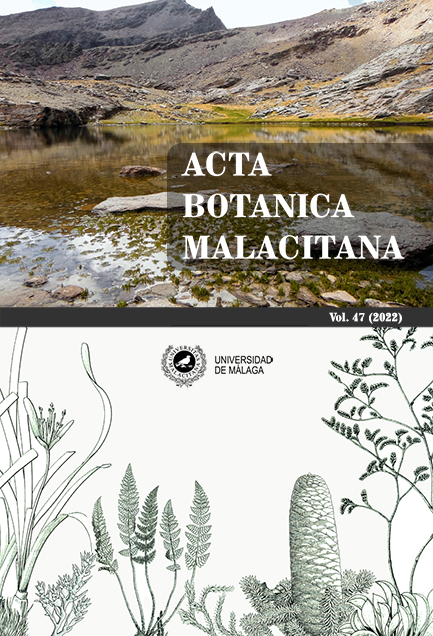First report of the invasive aquatic plant Elodea nuttallii (Hydrocharitaceae) in the Iberian Peninsula
DOI:
https://doi.org/10.24310/abm.v47i.13684Keywords:
Alien flora, invasive species, aquatic plants, Spain, Catalonia, PyreneesAbstract
Elodea nuttallii is reported for the first time in the Iberian Peninsula. A naturalized and well established population has been discovered in the upper river Ter, Catalonia.
Downloads
Metrics
References
Banfi, E. & Galasso, G. (2010). La flora essotica della Lombardia. Milano, Italy: Museo di Storia Naturale di Milano.
EPPO (2021). Elodea nuttallii dataheet. EPPO Global Database. European and Mediterranean Plant Protection Organization. Digital resource at https://gd.eppo.int/. Accessed on 2021-10-10.
Georgiev, V., Tsoneva, S., Kenderoc, L., Trichkova, T., Todorov, M. & Vladimirov, V. (2019). Distribution of Elodea nuttallii, an invasive alien species of EU concern, in Bulgaria. Phytologia Balcanica, 25(3), 417-423.
Greulich, S. & Trémolières, M. (2006). Present distribution of the genus Elodea in the Alsatian Upper Rhine floodplain (France) with a special focus on the expansion of Elodea nuttallii during recent decades. Hydrobiologia, 570, 249-255. doi: https://doi.org/10.1007/s10750-006-0188-y
Haynes, R. (2000). Hydrocharitaceae. In: Flora of North America Editorial Committee. Flora of North America North of Mexico, vol. 22. (Online). Oxford, UK: Oxford University Press. Digital resource at floranorthamerica.org. Accessed on 2021-10-10.
MNHN-Museum National d’Histoire Naturelle (2021). Fiche de Elodea nuttallii. Inventaire National du Patrimoine Naturel (INPN) Digital resource at inpn.mnhn.fr/espece/cd_nom/95983/tab/carte. Accessed on 2021-10-10.
Josefsson, M. (2011). NOBANIS – Invasive species fact sheet – Elodea canadensis, Elodea nuttallii, Elodea callitrichoides – Online Database of the European Network on Invasive Alien Species. Digital resource at nobanis.org. Accessed on 2021-10-10.
Prokopuk, M. & Zub, L. (2019). Peculiarities of Elodea (Hydrocharitaceae) in the aquatic systems of Ukraine (East Europe). Phytologia Balcanica, 25(3), 381-386.
Simpson, D.A. (1986). Taxonomy of Elodea Mchx. in the British Isles. Watsonia, 16, 1-14.
Simpson, D.A. (1988). Phenotypic plasticity of Elodea nuttallii and Elodea canadensis in the British Isles. Watsonia, 17, 121-123.
Simpson, D.A. (1990). Displacement of Elodea Canadensis by Elodea nuttallii in the British Isles. Watsonia, 18(2), 173-177.
Steen, B., Cardoso, A.C., Tsiamis, K., Engel, J. & Gervasini, E. (2019). Modelling hot spot areas for the invasive alien plant Elodea nuttallii in the EU. Management of Biological Invasions, 10(1), 151-170. doi: https://doi.org/10.3391/mbi.2019.10.1.10
Stace, C. (2010). New flora of the British Isles. Third Edition. Cambridge, UK: Cambridge University Press.
Talavera, S. & Gallego, M.J. (2010). Elodea Mchx. In: S. Talavera, M.J. Gallego, C. Romero & A. Herrero (Eds.). Flora iberica, Vol. 17 (pp. 36-38). Madrid: Real Jardín Botánico-C.S.I.C.
Thiebaut, G. (2005) Does competition for phosphate supply explain the invasion pattern of Elodea species? Water Research, 39(14), 3385-3393. doi: https://doi.org/10.1016/j.watres.2005.05.036
Thiebaut, G. & di Nino, F. (2009). Morphological variations of natural populations of an aquatic macrophyte Elodea nuttalii in their native habitat and in their introduced ranges. Aquatic invasions, 4(2), 311-320. doi://dx.doi.org/10.3391/ai.2009.4.2.2
Tison, J.M. & Foucault, B. (2014). Flora Gallica - Flore de France. Mèze, France: Biotope éditions.
Tison, J.M., Jauzein, P. & Michaud, H. (2014). Flore de la France méditerranéenne continentale. Conservatoire Botanique National Méditerranéen de Porquerolles. Turriers, France : Naturalia Publications.
Vandenporten, A., Lambinon, J. & Tignon, M. (2000). Morphological and molecular evidence of the confusion between Elodea callitrichoides and E, nuttallii in Belgium and northern France. Belgian Journal of Botany, 133, 41-52.
Downloads
Published
How to Cite
Issue
Section
License
All information related to the licensing of published works in Acta Botanica Malacitana and copyright can be found in our Editorial Policy.







1.png)
